
The left-hand panel of the Python Script Editor is used to manage Python scripts.

|
Contents [Hide] |
There are several ways to find a script in the list:
Click the list of scripts and begin typing the script name
Search by script name - Type a portion of the script name into the search field below the list of scripts.
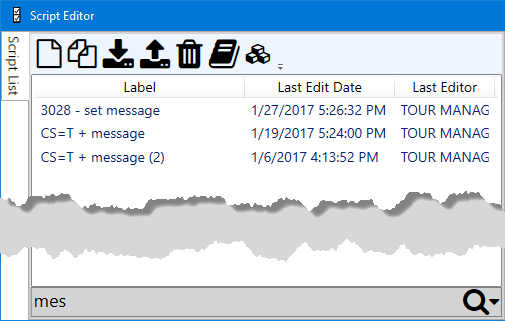
Search by
script contents - Click the  icon
at the end of the search field, click Search
Content, and then type a portion of the script contents
into the search field. (This computer will now default to
searching by content instead of script name until you turn
off this feature.)
icon
at the end of the search field, click Search
Content, and then type a portion of the script contents
into the search field. (This computer will now default to
searching by content instead of script name until you turn
off this feature.)
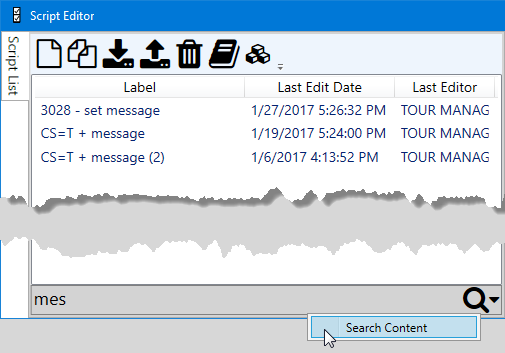
Sort
the displayed scripts in order by name (Label),
by Last Edit Date,
or by Last Editor.
Click on one of these column headers to sort by that column;
click that same column header again to reverse the sort order.
 Note: GainSeeker maintains three
separate lists of Python scripts - scripts for custom statistics, scripts
for dashboards, and scripts for data entry (via inspections or as standalone
scripts). This means that a script you create for inspections will not
be displayed when you are working with dashboard scripts or custom statistic
scripts, for example.
Note: GainSeeker maintains three
separate lists of Python scripts - scripts for custom statistics, scripts
for dashboards, and scripts for data entry (via inspections or as standalone
scripts). This means that a script you create for inspections will not
be displayed when you are working with dashboard scripts or custom statistic
scripts, for example.
Click the name of the script
to select it.
When a script is selected, you can edit,
debug, lock,
copy, export,
or delete
the script.
If you are currently editing the Formula test in an Inspection, a Python Dashboard Control in a Dashboard, or a Scripted DMS or Scripted SPC Retrieval in Dynamic Reports 2, you must also click the Select button (below the search field) to choose the selected script for the inspection test, dashboard control, or dynamic report.
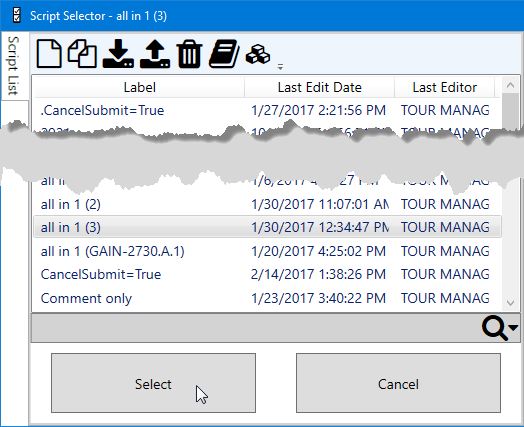
You can use toolbar buttons to create a new script.

Click the  (New)
toolbar button to create a new blank script.
(New)
toolbar button to create a new blank script.
Select
an existing script, and then click the  (Copy)
toolbar button to make a copy of the script.
(Copy)
toolbar button to make a copy of the script.
You can download sample Python scripts that were created for GainSeeker. In some cases, you will need to look for comments in the downloaded script that provide instructions for modifying the script to work correctly on your system.
The Script Library for data entry - inspections and standalone scripts - is different from the Script Library for dashboards. (There is also a Script Library for custom statistics.) These lists are updated periodically.
Click the  (Script Library) toolbar button to
open the Python Script Library.
(Script Library) toolbar button to
open the Python Script Library.

To import a sample Python script, select the script from the Python Scripts list and then click Add.
If you cannot access the script library, you can ask your IT department to grant you access to ftp://ftp.hertzler.com/python and its sub-folders.
You can use toolbar buttons to import and export scripts.

To import a script: click the  (Import)
button and choose the file to import.
(Import)
button and choose the file to import.
To export a script: select
the script to export, click the  (Export) button, and enter a file
name and location for the export file.
(Export) button, and enter a file
name and location for the export file.
Sometimes you may need to compare two similar scripts and identify the differences between them. You can use a toolbar button to do so.

Select
the first script for comparison and then click the  (Compare)
button on the toolbar.
(Compare)
button on the toolbar.
This will display the Select script
to compare window and highlight the script you just selected:
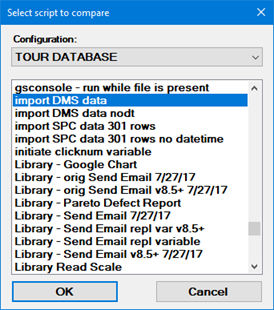
If you need to change to a different configuration to view
the second script, select it from the Configuration
list.
(This list is only available if you have rights
to 'See all users, roles, and configurations'.)
Select the second script for comparison, and then click OK.
GainSeeker saves the contents of both scripts as temporary files and then uses an external script comparison program to compare them.
By default, GainSeeker uses fc.exe - a file comparison tool that is included with the Windows operating system - to compare the contents of the two scripts. You can use the Inspection Editor Settings to configure this workstation for a different file comparison tool such as Winmerge.
Before you edit or delete a script, best practice is to investigate whether that script is run by any inspections, dashboards, other scripts - and ensure that the changes you make will not have an adverse effect. You can use a toolbar button to perform these checks.

To check for inspections, dashboards, and
other scripts that may run a particular script, select
the script and then click the  (Used
By) button.
(Used
By) button.
 Note:
If you have multiple configurations with separate tables for inspections
or dashboards but the same table for scripts, you should also log in to
those configurations and run this check.
Note:
If you have multiple configurations with separate tables for inspections
or dashboards but the same table for scripts, you should also log in to
those configurations and run this check.
Other tips and best practices for revision control of scripts:
Before editing a script, back
it up by archiving the script.
This keeps a record of previous code, so that you can go back to
it if needed. You can archive the same script multiple times to
keep a revision history of the script.
Before deleting a script, back
it up by exporting the script
to file.
If you later discover that you need the script again, it will be
much easier to import the script than to re-create it from memory.
Lock
any script that is used in production - by an inspection or dashboard,
by another script, or as a standalone script.
This will prevent that script from being accidentally deleted.
Archiving a script makes an offline backup of the current (live) script. You can archive the same script multiple times to keep a revision history of the script.
For each Python script in GainSeeker, you can use the Archive function to:
view any previously-archived versions of the script and view comments about those versions
archive the current (live) version of the script and enter a comment about this version
compare backups to each other and to the current (live) version of the script
copy the code from a previous version of the script
To archive the current version of any Python
script, or to view any older archived copies of a script, select
the script you want to work with and then click the  (Archive) button on the toolbar.
(Archive) button on the toolbar.

This will display the Manage Archive window for the script you just selected.
If there are no archived versions of this script, [CURRENT SCRIPT] will be the only script version listed.
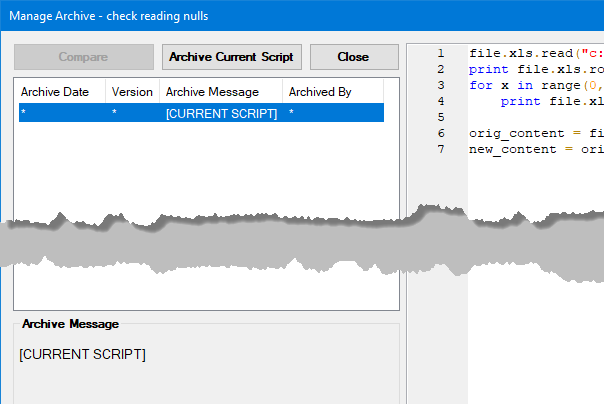
If archived versions of this script already exist, they will be listed here.

From this Manage Archive window, you can do the following:
To archive (back up) the current version of the script,
click Archive Current Script.
GainSeeker will prompt you to enter an optional Archive
Message, where you can enter a note about this version
you are archiving. (You will not
be able to change or remove this Archive Message later.)
After clicking Save for
the Archive Message, GainSeeker will add a copy of the current
script to the list of archived versions of the script.
Please note:
Archiving an Action-based script will store the equivalent code-only script.
There is not a function to delete any archived versions of a script.
To view or copy the code for an archived version of the
script, or to read the full Archive
Message for that version, click on that archived version.
You can copy the code by clicking in the code viewer, pressing
CTRL+A to select all of the text, and then pressing CTRL+C to
copy all of the text to the Windows clipboard.
If you need to revert to one of these archived versions of the
script, you can use this method to copy the archived code, then
edit the current script to delete its code and paste in this copied
code (using CTRL+V).
To compare any two script versions listed here (including
the [CURRENT SCRIPT]),
use the CTRL or SHIFT key to select any two script versions, and
then click the Compare
button.
GainSeeker will save the contents of both versions as temporary
files and then use an external script comparison program to compare
them. By default, GainSeeker uses fc.exe
- a file comparison tool that is included with the Windows operating
system - to compare the contents of the two scripts. You can use
the Inspection
Editor Settings to configure this workstation for a different
file comparison tool such as Winmerge.
You can also archive multiple scripts from the following GainSeeker modules:
GainSeeker Inspections module - archive all scripts used by an inspection
GainSeeker Charts module - archive all scripts used by a dashboard
GainSeeker Utility module - archive all scripts used by the current configuration
You can use a toolbar button to copy one or more scripts to a different configuration:

Click the  (Copy
to Configuration) button on the toolbar.
(Copy
to Configuration) button on the toolbar.
When prompted, select the Target
configuration to receive the copied scripts, and select
one or more Scripts to copy.

If the target configuration already contains scripts with
these names, those scripts will be overwritten.
However, you can automatically archive
those scripts before they are overwritten. Select Archive
scripts replaced in target configuration and Enter
a message to be stored with the archive.
Click Copy.
Best practice for deleting a script is to:
Investigate whether that script is run by any inspections, dashboards, other scripts.
Back up the script by exporting the script to file.
Select
the script you want to delete and then click the  (Delete)
button on the toolbar.
(Delete)
button on the toolbar.

If the script is locked, you
will need to unlock it before you can delete it.
Please note than any Archived revisions
of this script are not deleted, but they can only be accessed
with a SQL script.